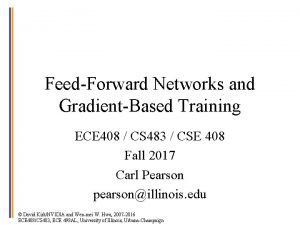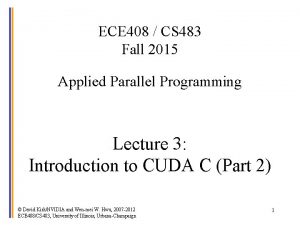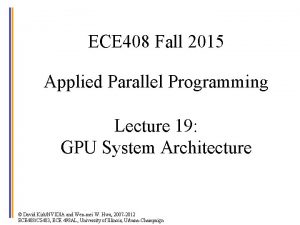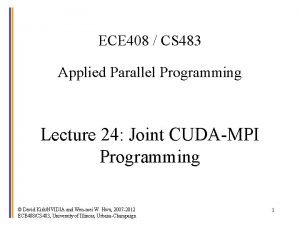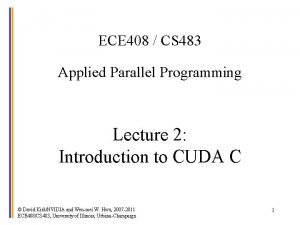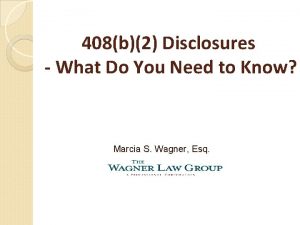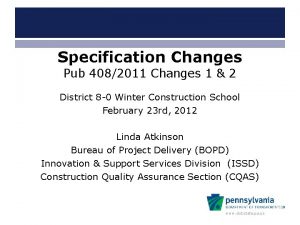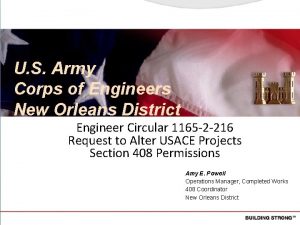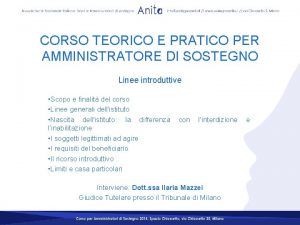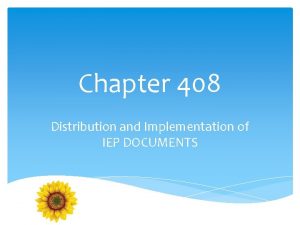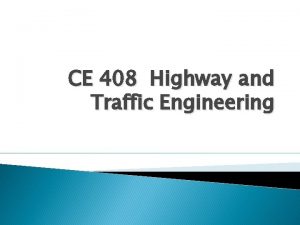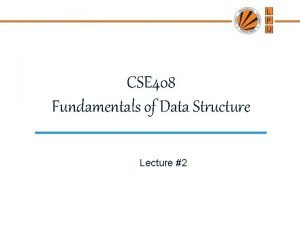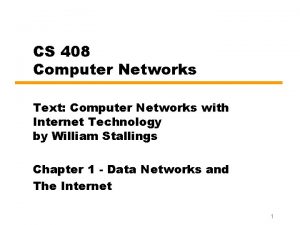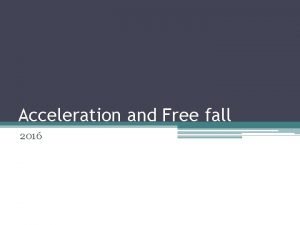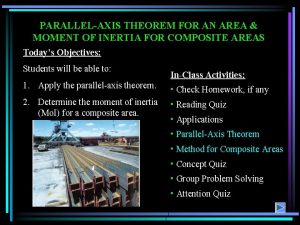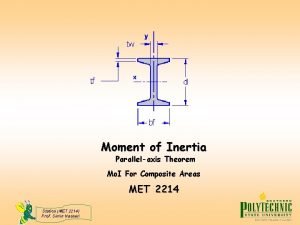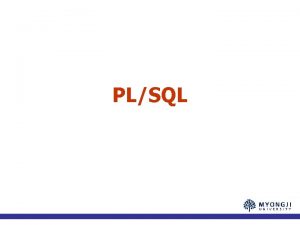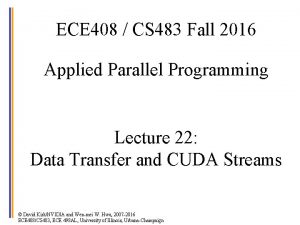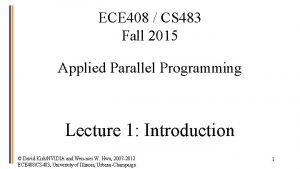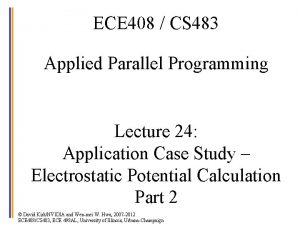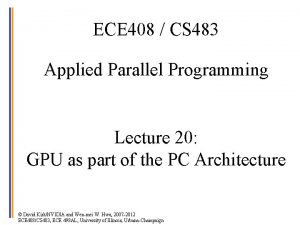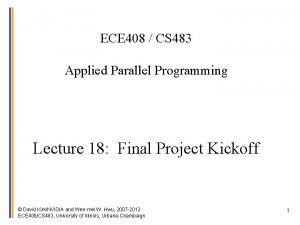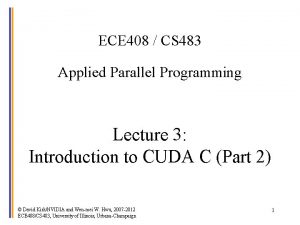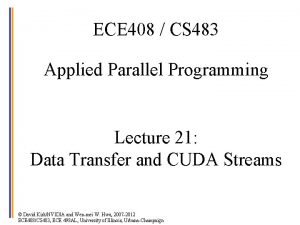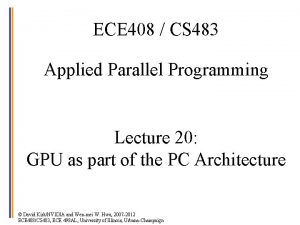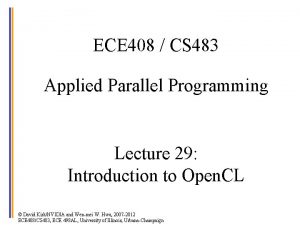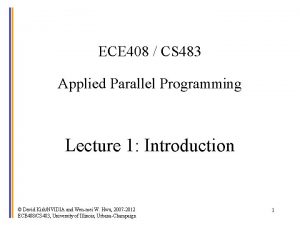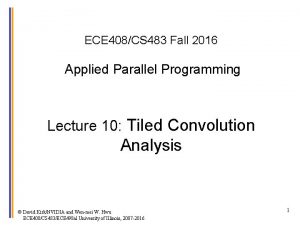ECE 408 CS 483 Fall 2016 Applied Parallel
















- Slides: 16

ECE 408 / CS 483 Fall 2016 Applied Parallel Programming Lecture 24: Application Case Study – Deep Learning © David Kirk/NVIDIA and Wen-mei W. Hwu, 2007 -2016 ECE 408/CS 483, ECE 498 AL, University of Illinois, Urbana-Champaign

2 Machine Learning • An important way of building applications whose logic is not fully understood. – No catastrophical consequence for incorrect output – Use labeled data – data that come with the input values and their desired output values – to learn what the logic should be – Capture each labeled data item by adjusting the program logic – Learn by example! • Training Phase – The system learns the logic for the application from labeled data. • Deployment (inference) Phase – The system applies the learned program logic in processing data © David Kirk/NVIDIA and Wen-mei W. Hwu, 2007 -2016 ECE 408/CS 483, ECE 498 AL, University of Illinois, Urbana-Champaign

Deep Learning in Computer Vision 100% 90% 80% 70% 60% 50% 40% 30% 20% 10% 0% Image. Net Traditional CV Deep Learning 2009 2010 2011 2012 2013 2014 2015 2016 Traditional Computer Vision Experts + Time Deep Learning Object Detection DNN + Data + HPC Slide courtesy of Steve Oberlin, NVIDIA © David Kirk/NVIDIA and Wen-mei W. Hwu, 2007 -2016 ECE 408/CS 483, ECE 498 AL, University of Illinois, Urbana-Champaign Deep Learning Achieves “Superhuman” Results

Recent Explosion of Deep Learning Applications • GPU computing hardware and programming interfaces such as CUDA has enabled very fast research cycle of deep neural net training • Computer Vision, Speech Recognition, Document Translation, Self Driving Cars, … • Most involve logic that were previously not effectively constructed with imperial programming • Using big labeled data to train and specialize DNN based classifiers – Deriving a large quantity of quality labeled data is a challenge © David Kirk/NVIDIA and Wen-mei W. Hwu, 2007 -2016 ECE 408/CS 483, ECE 498 AL, University of Illinois, Urbana-Champaign

5 Behind the Scenes • In 2010 Prof. Andreas Moshovos at University of Toronto adopted the ECE 498 AL Programming Massively Parallel Programming Class • Several of Prof. Geoffrey Hinton’s graduate students took the course • These students developed the GPU implementation of the DNN that was trained with 1. 2 M images to win the Image. Net competition © David Kirk/NVIDIA and Wen-mei W. Hwu, 2007 -2016 ECE 408/CS 483, ECE 498 AL, University of Illinois, Urbana-Champaign

6 Background: Combinations Logic Specification – Truth Table a’ a b’ b c’ c Input a b c output 0 0 0 1 1 0 1 0 1 0 0 1 1 0 0 1 1 © David Kirk/NVIDIA and Wen-mei W. Hwu, 2007 -2016 ECE 408/CS 483, ECE 498 AL, University of Illinois, Urbana-Champaign

Different modalities of Real-world Data Images/video Image Vision features Detection Audio features Speaker ID Text classification, machine translation, information retrieval, . . Text features Slide courtesy of Andrew Ng, Stanford University © David Kirk/NVIDIA and Wen-mei W. Hwu, 2007 -2016 ECE 408/CS 483, ECE 498 AL, University of Illinois, Urbana-Champaign

8 What if we did not know the truth table? • Look at enough observation data to construct the rule – 000 → 0 – 011 → 0 – 100 → 1 – 110 → 0 • If we have enough observational data to cover all input patterns, we can construct the truth table and derive the logic! © David Kirk/NVIDIA and Wen-mei W. Hwu, 2007 -2016 ECE 408/CS 483, ECE 498 AL, University of Illinois, Urbana-Champaign

Multilayer Perceptron Synaptic Weights Universal for function approximation SUPERVISED TRAINING CLASSIFICATION SYNAPTIC WEIGHTS [Cybenko, 1989; etc. ] Combinational Logic of AI © David Kirk/NVIDIA and Wen-mei W. Hwu, 2007 -2016 ECE 408/CS 483, ECE 498 AL, University of Illinois, Urbana-Champaign 9

1 0 Le. Net-5, a convolutional neural network for hand-written digit recognition This is a 1024*8 bit input, which will have a truth table of 2 8196 entries © David Kirk/NVIDIA and Wen-mei W. Hwu, 2007 -2016 ECE 408/CS 483, ECE 498 AL, University of Illinois, Urbana-Champaign

1 1 Forward Propagation Path of a Convolution Layer • All input feature maps contribute to all output feature maps. One convolution mask is provided for each input-output combination. © David Kirk/NVIDIA and Wen-mei W. Hwu, 2007 -2016 ECE 408/CS 483, ECE 498 AL, University of Illinois, Urbana-Champaign

1 2 Example of the Forward Path of a Convolution Layer 7 1*1+ 1*2 + 2*1 5 2 1*0+ 1*2 + 1*0 + 1*3 © David Kirk/NVIDIA and Wen-mei W. Hwu, 2007 -2016 ECE 408/CS 483, ECE 498 AL, University of Illinois, Urbana-Champaign

1 3 recognition. Le. Net-5, a convolutional neural network for hand-written digit recognition © David Kirk/NVIDIA and Wen-mei W. Hwu, 2007 -2016 ECE 408/CS 483, ECE 498 AL, University of Illinois, Urbana-Champaign

1 4 Sequential Code for the Forward Path of a Convolution Layer void conv. Layer_forward(int M, int C, int H, int W, int K, float* X, float* W, float* Y) { int m, c, h, w, p, q; int H_out = H – K + 1; int W_out = W – K + 1; } for(int m = 0; m < M; m++) // for each output feature map for(int h = 0; h < H_out; h++) // for each output element for(int w = 0; w < W_out; w++) { Y[m, h, w] = 0; for(int c = 0; c < C; c++) // sum over all input feature maps for(int p = 0; p < K; p++) // Kx. K filter for(int q = 0; q < K; q++) Y[m, h, w] += X[c, h + p, w + q] * W[m, c, p, q]; } © David Kirk/NVIDIA and Wen-mei W. Hwu, 2007 -2016 ECE 408/CS 483, ECE 498 AL, University of Illinois, Urbana-Champaign

1 5 Sequential code for the Forward Path of a Sub-sampling Layer void pooling. Layer_forward(int M, int H, int W, int K, float* Y, float* S) { for(int m = 0; m < M; m++) // for each output feature maps for(int h = 0; h < H/K; h++) // for each output element for(int w = 0; w < W/K; w++) { S[m, x, y] = 0. ; for(int p = 0; p < K; p++) { // loop over Kx. K input samples for(int q = 0; q < K; q++) S[m, h, w] += Y[m, K*h + p, K*w + q] /(K*K); } // add bias and apply non-linear activation S[m, h, w] = sigmoid(S[m, h, w] + b[m]) } } © David Kirk/NVIDIA and Wen-mei W. Hwu, 2007 -2016 ECE 408/CS 483, ECE 498 AL, University of Illinois, Urbana-Champaign

ANY QUESTIONS? © David Kirk/NVIDIA and Wen-mei W. Hwu, 2007 -2016 ECE 408/CS 483, ECE 498 AL, University of Illinois, Urbana-Champaign
